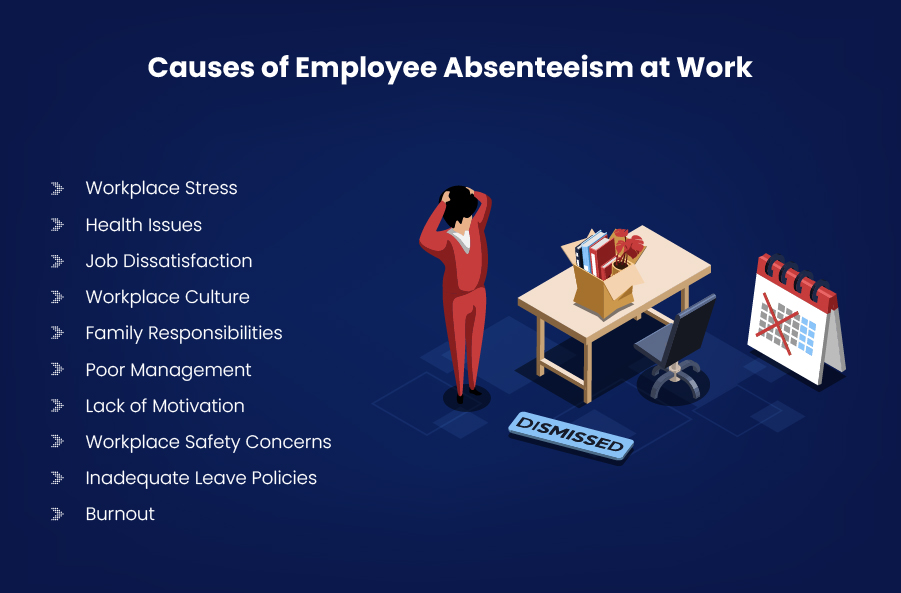
Top 10 Factors Causing Employee Absenteeism and Solutions to Address Them
When employee absenteeism becomes a recurring issue at work, it's not just their contributions to the company that are affected. It puts pressure on so many people: HR, line managers, other employees on the team, and even the finance department. If there are no employees at work, there's no progress on projects.
That's exactly why businesses put so much emphasis on attendance policies and modern tools for smarter attendance and leave management. In some cases, they even initiate dedicated employee absenteeism projects to address the root causes.
Even if an employee's unplanned absences in a year are as low as 7 days, it could still cause thousands of rupees in losses for the company. So, what are the causes of employee absenteeism, and how to reduce employee turnover and absenteeism? This post explores the top 10 factors leading to employee absenteeism, along with helpful tips to keep them coming to work.
What Is Employee Absenteeism?
Employee Absenteeism refers to instances where an employee fails to report to work without prior approval. It excludes any scheduled vacations or authorised leaves.
Unplanned absences, when they are recurring instances of unapproved time off or sporadic, can disrupt team productivity and impact business operations.
According to a 2023 Gallup study, Close to $8.8 trillion, which equals 9 percent of the global GDP, is lost in productivity each year due to employee disengagement, for which employee absenteeism is a major contributor.
What Are the Causes of Employee Absenteeism?

Various studies that probed into the patterns, reasons, and impacts of employee absenteeism reveal that there are multiple contributing factors, both personal and organisational. Each workplace may have a unique employee absenteeism rate, and identifying the underlying reasons often requires a deeper analysis of employee behaviour, work culture, and management practices. The 10 most frequently occurring factors are discussed below.
- Workplace Stress
- Health Issues
- Job Dissatisfaction
- Workplace Culture
- Family Responsibilities
- Poor Management
- Lack of Motivation
- Workplace Safety Concerns
- Inadequate Leave Policies
- Burnout
1. Workplace Stress
If you take the time to prepare an employee absenteeism chart and analyse the number one reason for unplanned absences, you will find that excessive workplace stress is a leading cause. When the workload becomes overwhelming, deadlines turn relentless, and work-life integration starts to break down, it creates a pressure-cooker environment for the employees.
When employees feel constantly stretched thin, their mental and physical well-being will start to deteriorate. Next, what you often notice is a rise in absenteeism, with burnout symptoms leading to frequent unplanned leaves.
How to Reduce Employee Turnover and Absenteeism from Workplace Stress?
- Roll out periodic stress management workshops and programs for the employees
- Try to gauge employee well-being and work-life balance through regular check-ins and anonymous feedback systems
- Redistribute tasks evenly among team members with realistic deadline-setting
2. Health Issues
Physical ailments and mental health challenges, including chronic conditions, anxiety disorders, and depression, are other significant drivers of employee absenteeism. Health problems, if they are left unaddressed, can compound over time. Before they start to create a vicious cycle for the employees, where recovery becomes harder and work stress piles on, it’s important to offer the right support systems.
How to Reduce Health-Related Employee Absenteeism?
- Offer medical insurance and mental health coverage
- Organise regular health screenings and wellness assessments
- Implement return-to-work programs with flexible work options
- Create supportive accommodation policies for health recovery
3. Job Dissatisfaction
If you notice specific employees showing a pattern of disengagement and absences, it is a sign that they are not experiencing job satisfaction. Job dissatisfaction causes people to feel disconnected from their roles. It could be due to a series of factors. A lack of fulfilment, purpose, or a clear career trajectory.
What shows up as absenteeism is just their physical absence. They have already checked out of their responsibilities. Before taking disciplinary steps, many organisations choose to issue a warning letter to employees for absence in word format to formally address the issue.
How to Address Job Dissatisfaction and Reduce Absenteeism?
- Conduct comprehensive employee engagement surveys and assessments
- Create mentorship programs and clear promotion pathways
- Implement job rotation and cross-training opportunities
- Match employee roles with personal interests and strengths
4. Workplace Culture

A toxic or unsupportive workplace culture breeds negativity, erodes employee morale, and creates an environment where staff members dread coming to work. Without addressing the root causes of an unhealthy culture, there is no point in issuing show cause notice to employees for absenteeism.
Top 10 Signs of a Toxic Workplace Culture
- High employee turnover rates.
- Poor communication, lack of transparency.
- Constant gossip, backstabbing are prevalent.
- Leadership lacks empathy, always micromanages.
- Blame culture, fear of failure.
- Unfair treatment, favouritism.
- Lack of work-life balance.
- No recognition for achievements.
- Employee burnout, high stress.
- Resistance to change.
It is important to realise that absenteeism is a coping mechanism for employees to escape an atmosphere which appears hostile to them.
How to Improve Workplace Culture to Reduce Absenteeism?
- Promote diversity initiatives and celebrate cultural differences
- Establish peer-to-peer recognition systems and achievement awards
- Organise team-building activities and cross-departmental projects
- Create inclusive policies ensuring equal opportunities for all
5. Family Responsibilities
Family obligations, particularly childcare duties, eldercare responsibilities, and family emergencies, might force employees to choose between work commitments and family needs. An employee is a whole person. They must carry both family responsibilities and job responsibilities. One cannot cancel out the other. This is where work-life balance becomes so essential.
Without supportive policies and proactive HR strategies, employees can only resort to unplanned absences to fulfil their personal obligations.

How to Support Family Responsibilities and Reduce Employee Absenteeism?
- Introduce remote work options and flexible scheduling
- Offer on-site childcare and eldercare assistance programs
- Develop parental leave programs and family emergency protocols
- Create dependent care assistance and family-friendly policies
6. Poor Management
Poor management is often the real reason behind high morale absenteeism and employee turnover. Inadequate supervisory support or a lack of leadership effectiveness can take a toll on how employees experience their daily work.
Studies confirm that the fastest way to make employees disengaged and prone to avoiding work is to deprive them of guidance, feedback, and recognition.
How to Address Poor Management and Reduce Absenteeism?
- Develop tailored leadership programs and provide training on effective communication techniques.
- Implement routine tracking of individual engagement outcomes and encourage clear two-way dialogue across all levels of the organisational hierarchy
- Facilitate active learning mentor schemes for newly appointed middle and junior executives
- Deploy structured performance feedback processes as well as group coaching sessions
7. Lack of Motivation
It is very common for an unmotivated employee to feel a sense of purposelessness when it comes to their professional responsibilities. They tend to exhibit this through a lower involvement at work and a rise in absenteeism. Sending a warning letter to an employee for absenteeism should only be taken as a last resort. Before that, take the following workforce productivity measures to rectify it.
- Implement employee assistance programs (EAPs) integrated with attendance bonuses and tiered reward systems
- Introduce employee recognition programs like employee of the month and peer nomination systems.
- Communicate overarching organisational goals and highlight how individual contributions make a difference.
- Synthesise personal values with the firm’s goals and vision
8. Workplace Safety Concerns

Businesses cannot simply hire an employee these days by promising a big paycheck. Along with the pay, they value so many other factors. Workplace safety is one of them. Unsafe or unhealthy work environments, for instance, can make them feel anxious and unsupported.
If safety protocols are overlooked, employees may choose to stay home on certain days when they perceive a higher risk of injury or danger at work.
How to Address Workplace Safety Concerns and Reduce Employee Absenteeism?
- Conduct regular safety audits and update protocols
- Supply necessary safety gear and conduct training sessions
- Implement safety committees and encourage incident reporting
- Reward safety-conscious behaviour and maintain certification requirements
9. Inadequate Leave Policies
When attendance and leave policies are rigid or insufficient, employees are left in difficult situations where they must choose between personal needs and job security. Without a way to get their legitimate time-off requests approved, employees will resort to calling in sick or taking unauthorised absences.
How to Improve Leave Policies and Reduce Absenteeism?
- Create generous PTO banks and vacation policies and implement them using attendance management software.
- Provide mental health days and personal day options
- Incorporate sabbatical opportunities and emergency leave provisions in the policy
- Establish clear approval procedures and advance notice requirements through the leave and attendance management system
10. Burnout

Burned-out employees often take frequent time off to recover. As a result, when you check the employee's absent report, you might notice a pattern of repeated short-term absences or an increase in last-minute leave requests.
Burnout is a state of physical and emotional exhaustion which often results from prolonged stress. If not addressed promptly, it can begin to impact an employee’s daily functioning and overall productivity.
How to Prevent Burnout and Reduce Absenteeism?
- Train employees on stress management techniques and mindfulness.
- Mandate lunch breaks and promote vacation usage
- Train managers to identify burnout symptoms early
- Provide mental health resources and create recovery plans
The Path Forward
Employee absenteeism is a persistent challenge that must be addressed with a deeper understanding of what drives people to stay engaged at work. We believe you could get a clearer picture of the factors that cause it and how to address them to build a more consistent workforce.
The role of the attendance management system in keeping absenteeism in check is crucial. It helps you spot the early signs of it in the form of an insightful employee absenteeism chart. You know exactly who’s frequently absent, when patterns start to form, and where intervention is needed.
Want to explore how our attendance management system can help you achieve this? Let's talk.
FAQ
How to measure employee absenteeism?
Get the number of days the employee was absent over a specific period, for instance, a month, and then compare it against the number of working days in that period.
How to calculate employee absenteeism rate monthly?
You can calculate the employee absenteeism rate by month by using the formula (Total unexcused absences ÷ Total scheduled workdays) × 100.
How to write a warning letter to employee for absenteeism?
Issuing the employee warning letter for absenteeism can be a corrective step to curb it. When you draft the letter, mention the absence dates, how it violated the policies, and what impact it had on the work. Write it in a formal tone. Don’t forget to file a copy for future reference.
What are the causes of employee absenteeism?
Common causes that lead to staff no-shows include health issues, stress, burnout, lack of engagement, poor management, personal responsibilities, unsafe workplaces, and rigid leave policies.
Can I terminate an employee for excessive absenteeism?
Yes. However, make sure that a decision for termination is made only after trying various other methods, like issuing a warning letter to employee for absenteeism. Also, ensure there is a fair evaluation and adherence to company policy and labour laws to avoid legal complications.
Most Popular Post

Why Accurate Attendance and Leave Management Matters for Business Growth?
Read More →Why Accurate Attendance and Leave Management Matters for Business Growth?
How To Leverage Attendance Data For Better Workforce Management?
Read More →How To Leverage Attendance Data For Better Workforce Management?




